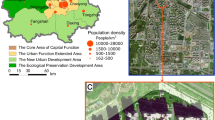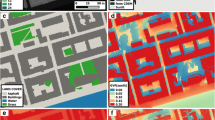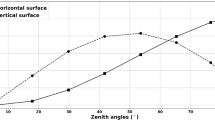Abstract
The solar and longwave environmental irradiance geometry (SOLWEIG) model simulates spatial variations of 3-D radiation fluxes and mean radiant temperature (T mrt) as well as shadow patterns in complex urban settings. In this paper, a new vegetation scheme is included in SOLWEIG and evaluated. The new shadow casting algorithm for complex vegetation structures makes it possible to obtain continuous images of shadow patterns and sky view factors taking both buildings and vegetation into account. For the calculation of 3-D radiation fluxes and T mrt, SOLWEIG only requires a limited number of inputs, such as global shortwave radiation, air temperature, relative humidity, geographical information (latitude, longitude and elevation) and urban geometry represented by high-resolution ground and building digital elevation models (DEM). Trees and bushes are represented by separate DEMs. The model is evaluated using 5 days of integral radiation measurements at two sites within a square surrounded by low-rise buildings and vegetation in Göteborg, Sweden (57°N). There is good agreement between modelled and observed values of T mrt, with an overall correspondence of R 2 = 0.91 (p < 0.01, RMSE = 3.1 K). A small overestimation of T mrt is found at locations shadowed by vegetation. Given this good performance a number of suggestions for future development are identified for applications which include for human comfort, building design, planning and evaluation of instrument exposure.












Similar content being viewed by others
References
Akbari H, Taha H (1992) The impact of trees and white surfaces on residential heating and cooling energy use in four Canadian cities. Energy 17(2):141–149
Akbari H, Kurn DM, Bretz SE, Hanford JW (1997) Peak power and cooling energy savings of shade tree. Energy Build 25:139–148
Akbari H, Pomerantz M, Taha H (2001) Cool surfaces and shade trees to reduce energy use and improve air quality in urban areas. Sol Energy 70:295–310
Ali-Toudert F, Mayer H (2007) Effects of asymmetry, galleries, overhanging façades and vegetation on thermal comfort in urban street canyons. Sol Energy 81:742–754
Ali-Toudert F, Djenane M, Bensalem R, Mayer H (2005) Outdoor thermal comfort in the old desert city of Beni-Isguen, Algeria. Clim Res 28:243–256
ASHRAE (2001) ASHRAE fundamentals handbook 2001 (SI Edition), Vol. American Society of Heating, Refrigerating, and Air-Conditioning Engineers, ISBN: 1883413885
Chapman L (2008) An introduction to ‘upside-down’ remote sensing. Prog Phys Geogr 32:529–542
Dragoni D, Schmid HP, Wayson CA, Potter H, Grimmond CSB, Randolph JC (2010) Evidence of increased net ecosystem productivity associated with a longer vegetated season in a deciduous forest in south-central Indiana, USA. Glob Chang Biol. doi:10.1111/j.1365-2486.2010.02281.x
Eliasson I, Knez I, Westerberg U, Thorsson S, Lindberg F (2007) Climate and behaviour in a Nordic city. Lanscape Urban Plann 82:72–84
Fanger PO (1970) Thermal comfort. Danish Technical Press, Copenhagen
Gagge AP, Fobelets AP, Berglund LG (1986) A standard predictive index of human response to the thermal environment. ASHRAETrans 92:709–731
Greater London Authority (2010) The draft climate change adaptation strategy for London. pp 138. Available at: http://www.london.gov.uk/climatechange/sites/climatechange/staticdocs/Climiate_change_adaptation.pdf
Honjo T, Takakura T (1990–1991) Simulation of thermal effects of urban green areas on their surrounding areas. Energy Build 15:443–446
Höppe P (1992) A new procedure to determine the mean radiant temperature outdoors. Wetter Leben 44:147–151
IPCC (2007) AR4 Synthesis report, full report, intergovernmental panel on climate change. Available at: http://www.ipcc.ch/pdf/assessment-report/ar4/syr/ar4_syr.pdf
Jonsson P, Eliasson I, Holmer B, Grimmond CSB (2006) Longwave incoming radiation in the Tropics: results from field work in three African cities. Theor Appl Climatol 85:185–201
Lindberg F (2005) Towards the use of local governmental 3-d data within urban climatology studies. Mapp Image Sci 2:32–37
Lindberg F (2007) Modelling the urban climate using a local governmental geo-database. Meteorol Appl 14:263–273
Lindberg F, Grimmond CSB (2010) Continuous sky view factor maps from high resolution urban digital elevation models. Clim Res 42:177–183
Lindberg F, Holmer B, Thorsson S (2008) SOLWEIG 1.0—Modelling spatial variations of 3D radiant fluxes and mean radiant temperature in complex urban settings. Int J Biometeorol 52:697–713
Martilli A (2009) On the derivation of input parameters for urban canopy models from urban morphological datasets. Bound-Lay Meteorol 130:301–306
Matzarakis A, Mayer H, Iziomon MG (1999) Applications of a universal thermal index: physiological equivalent temperature. Int J Biometeorol 43:76–84
Matzarakis A, Rutz F, Mayer H (2009) Modelling radiation fluxes in simple and complex environments: basics of the RayMan model. Int J Biometeorol 54:131–139
Mayer H, Höppe P (1987) Thermal comfort of man in different urban environments. Theor Appl Climatol 38:43–49
Mayer H, Holst J, Dostal P, Imbery F, Schindler D (2008) Human thermal comfort in summer within an urban street canyon in Central Europe. Meteorol Z 17:241–250
Meehl GA, Tebaldi C (2004) More intense, more frequent, and longer lasting heat waves in the 21st century. Science 305:994–997
Offerle B, Grimmond CSB, Oke TR (2003) Parameterization of net all-wave radiation for urban areas. J Appl Meteorol 42:1157–1173
Oke TR (1987) Boundary layer climates. Routledge, Cambridge
Oke TR (1989) The micrometeorology of the urban forest. Philos Trans R Soc Lond B 324:335–349
Pascal M, Laaidi K, Ledrans M, Baffert E, Caserio-Schönemann C, Le Tertre A, Manach J, Medina S, Rudant J, Empereur-Bissonnet P (2006) France’s heat health watch warning system. Int J Biometeorol 50:144–153
Picot X (2004) Thermal comfort in urban spaces: impact of vegetation growth—case study: Piazza della Scienza, Milan, Italy. Energy Build 36:329–334
Ratti CF, Richens P (1999) Urban texture analysis with image processing techniques. In: Proceedings of the CAADFutures99, Atalanta, GA
Ratti CF, Richens P (2004) Raster analysis of urban form. Environ Plann B Plann Des 31:297–309
Ratti CF, Di Sabatino S, Britter R (2006) Urban texture analysis with image processing techniques: winds and dispersion. Theor Appl Climatol 84:77–90
Reindl DT, Beckman WA, Duffie JA (1990) Diffuse fraction correlation. Sol Energy 45:1–7
Robitu M, Musy M, Inard C, Groleau D (2006) Modeling the influence of vegetation and water pond on urban microclimate. Sol Energy 80:435–447
Schmid HP, Cleugh HA, Grimmond CSB, Oke TR (1991) Spatial variability of energy fluxes in suburban terrain. Bound-Lay Meteorol 54:249–276
Thorsson S, Lindberg F, Eliasson I, Holmer B (2007) Different methods for estimating the mean radiant temperature in an outdoor urban setting. Int J Climatol 27:1983–1993
Upmanis H, Eliasson I, Lindqvist S (1998) The influence of green areas on nocturnal temperatures in a high latitude city (Goteborg, Sweden). Int J Climatol 18:681–700
VDI (1994) VDI 3789. Part II: Environmental meteorology, interactions between atmosphere and surface; calculation of short-and long wave radiation. VDI/DIN-Handbuch Reinhaltung der Luft, Band 1b, Düsseldorf
VDI (1998) VDI 3789. Part I: Climate. VDI/DIN-Handbuch Reinhaltung der Luft, Band 1b, Düsseldorf
WHO/WMO/UNEP (1996) Climate and health: the potential impacts of climate change. Geneva, Switzerland
Yu B, Liu H, Wu J, Lin W-M (2009) Investigating impacts of urban morphology on spatio-temporal variations of solar radiation with airborne LIDAR data and a solar flux model: a case study of downtown Houston. Int J Remote Sens 30:4359–4385
Zipperer WC, Sisinni SM, Pouyat RV, Foresman TW (1997) Urban tree cover: an ecological perspective. Urban Ecosyst 1:229–246
Acknowledgements
This work is financially supported by FORMAS—the Swedish Research Council for Environment, Agricultural Sciences and Spatial Planning and by European Community’s Seventh Framework Programme FP/2007–2011 BRIDGE (211345) project. The authors would like to thank the Meteorological Institute, University of Freiburg for providing human-biometeorological data from the KLIMES-project. The interface can be downloaded from the Göteborg Urban Climate Group-website (http://www.gvc2.gu.se/ngeo/urban/urban.htm).
Author information
Authors and Affiliations
Corresponding author
Rights and permissions
About this article
Cite this article
Lindberg, F., Grimmond, C.S.B. The influence of vegetation and building morphology on shadow patterns and mean radiant temperatures in urban areas: model development and evaluation. Theor Appl Climatol 105, 311–323 (2011). https://doi.org/10.1007/s00704-010-0382-8
Received:
Accepted:
Published:
Issue Date:
DOI: https://doi.org/10.1007/s00704-010-0382-8




